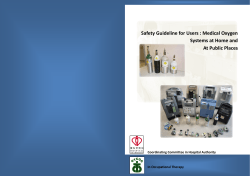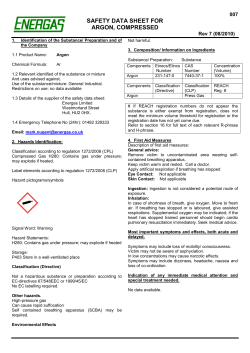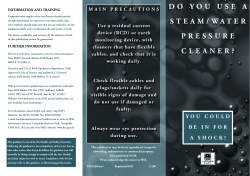
Take care with oxygen Fire and explosion hazards in the use of oxygen
Health and Safety Executive Take care with oxygen Fire and explosion hazards in the use of oxygen This leaflet provides information on the fire and explosion hazards in the use of oxygen. It is for anyone who uses oxygen gas in cylinders. Hazards from oxygen Oxygen gas in cylinders is used by many people at work and sometimes at home. It is used: in welding, flame cutting and other similar processes; for helping people with breathing difficulties; in hyperbaric chambers as a medical treatment; in decompression chambers for people who work in compressed air or in deepsea diving; ❋ for food preservation and packaging; ❋ in steelworks and chemical plants. ❋ ❋ ❋ ❋ The air we breathe contains about 21% oxygen. Without oxygen we would die in a matter of minutes. It may be hard to believe, but oxygen can also be dangerous. The dangers are fire and explosion. Oxygen behaves differently to air, compressed air, nitrogen and other inert gases. It is very reactive. Pure oxygen, at high pressure, such as from a cylinder, can react violently with common materials such as oil and grease. Other materials may catch fire spontaneously. Nearly all materials including textiles, rubber and even metals will burn vigorously in oxygen. Even a small increase in the oxygen level in the air to 24% can create a dangerous situation. It becomes easier to start a fire, which will then burn hotter and more fiercely than in normal air. It may be almost impossible to put the fire out. A leaking valve or hose in a poorly ventilated room or confined space can quickly increase the oxygen concentration to a dangerous level. The main causes of fires and explosions when using oxygen are: ❋ ❋ ❋ ❋ oxygen enrichment from leaking equipment; use of materials not compatible with oxygen; use of oxygen in equipment not designed for oxygen service; incorrect or careless operation of oxygen equipment. Risk assessment Employers are legally required to assess the risks in the workplace, and take all reasonably practicable precautions to ensure the safety of workers and members of the public. A careful examination of the risks from using oxygen should be included in the risk assessment. 1 of 6 pages Health and Safety Executive Beware of oxygen enrichment Oxygen enrichment is the term often used to describe situations where the oxygen level is greater than in air. Oxygen is colourless, odourless and tasteless. The presence of an oxygen enriched atmosphere cannot be easily detected by the human senses. The main danger to people from an oxygen enriched atmosphere is that clothing or hair can easily catch fire, causing serious or even fatal burns. For example, people can easily set their clothing and bedding on fire by smoking while receiving oxygen treatment for breathing difficulties. Smoking should be forbidden where oxygen is being used. Oxygen enrichment is often the result of: ❋ ❋ ❋ ❋ ❋ ❋ leaks from damaged or poorly maintained hoses, pipes and valves; leaks from poor connections; opening valves deliberately or accidentally; not closing valves properly after use; using an excess of oxygen in welding, flame cutting ora similar process; poor ventilation where oxygen is being used. Consequently, the main ways to prevent oxygen enrichment are to keep oxygen equipment in good condition and to take care when using it. Good ventilation will also reduce the risk of oxygen enrichment. Oxygen enrichment can also result from the misuse of oxygen. Never use oxygen for: ❋ ❋ cooling or refreshing the air in confined spaces; dusting benches, machinery or clothing. If oxygen enrichment from an oxygen leak is suspected, the oxygen supply should be turned off. Cigarettes and open flames should be extinguished. The room should be well ventilated and the source of the leak identified and repaired. It is possible that oxygen may contaminate any clothing in the area. If this is suspected, the clothing should preferably be removed and taken outside for airing and ventilating. Confined spaces Some of the most serious oxygenrelated incidents have involved damaged oxygen hoses leaking into confined spaces, where welding and burning operations were taking place. The workers’ oxygen enriched clothing caught fire, causing serious or fatal injuries. Gas cylinders should not be taken into confined spaces; the gas can be fed in by using hoses. The hoses should be removed from the confined space when work is finished or suspended, such as at the end of each day. Where this is not practicable, the hoses should be disconnected from the gas supply at the cylinder or manifold. Where the risk from oxygen enrichment is high, such as in a confined space or a poorly ventilated room, the use of oxygen monitoring equipment is advisable. Take care with oxygen 2 of 6 pages Health and Safety Executive Never use materials incompatible with oxygen Some materials react explosively if they come into contact with pure oxygen at high pressure. Other materials may catch fire spontaneously. Such materials are incompatible with oxygen. Equipment designed for oxygen service is made from materials and components that have been tested and proved to be compatible, and are safe for the purpose. The reasons for a particular design and choice of material are not always obvious. Using substitute materials or components, which appear to be similar but are not proven to be oxygen compatible, is extremely dangerous and has caused many accidents. You need to take care when replacing: Orings and gaskets There are hundreds of different types of rubber and elastomer, and most are not compatible with oxygen. Metal components Many metals and alloys are not suitable for use with oxygen. Pressure regulators You must ensure that the pressure rating of the regulator is not less than the full cylinder supply pressure. Pressure regulators for gas welding equipment should comply with BS EN ISO 2503 and for medical gases with BS EN 738. Many existing regulators were made to standards which have now been withdrawn such as BS 5741, BS 7650 and BS EN 585. These regulators may not be suitable for pressures above 200 bar. If in doubt, check with the supplier or manufacturer. Oxygen hoses The flexible oxygen hose used for welding, etc, should comply with BS EN 559 or BS EN 739. Lubricants As a rule, lubricants should be avoided. Only lubricants that are made for oxygen service, and are specified by the equipment supplier, should be used. Tape Tape should be avoided. Only tape that is marked as suitable for oxygen service, and is specified by the equipment supplier, should be used. Other components In some cases, the materials may appear to be compatible but the shape and configuration of components may be important in minimising the fire risk. Only components approved by the manufacturer should be used when maintaining oxygen equipment. You should always ensure that highpressure oxygen systems are designed, constructed, installed and commissioned by competent people who have specialised knowledge of the subject. All oxygen apparatus and equipment must be properly identified with the gas name and safe working pressure. Take care with oxygen 3 of 6 pages Health and Safety Executive Never use oxygen in equipment not designed for it Many serious accidents have been caused by using oxygen instead of other gases such as air, compressed air or nitrogen. Oxygen can react explosively with oils and greases. People have been injured or even killed when pumps, engines, tyres and pressure equipment have been blown apart by the explosion. Oxygen can also cause other materials to ignite spontaneously. The resulting fire can cause damage to equipment and injury to people. You should never use oxygen for: ❋ ❋ ❋ ❋ ❋ driving pneumatic tools; inflating vehicle tyres; pressurising and purging systems; replacing air or inert gas; starting diesel engines. Oxygen must not be introduced into any equipment unless it has been designed for oxygen service by competent people with specialist knowledge. Take care with oxygen cylinders and equipment If oxygen cylinders and equipment are used carelessly or incorrectly, then a fire may result. All users of oxygen should know and understand the dangers, and should receive training in the use of oxygen equipment. There are a number of precautions to follow when using oxygen equipment. Oxygen cylinders You should always: ❋ handle oxygen cylinders carefully. Use a purposebuilt trolley to move them; ❋ keep cylinders chained or clamped to prevent them from falling over; ❋ store oxygen cylinders when not in use in a wellventilated storage area or compound, away from combustible materials and separated from cylinders of flammable gas. Oxygen equipment You should always: ❋ open the valve slowly. Rapid opening, particularly of cylinder valves, can result in momentarily high oxygen velocities. Any particles will be pushed through the system very quickly, causing frictional heat. Alternatively, if the system has a dead end such as where a pressure regulator is connected to an oxygen cylinder, heat can be generated through compression of the oxygen. Both cases can result in a fire; ❋ ensure that the pressure adjusting screw of the pressure regulator is fully unwound, so that the regulator outlet valve is closed before opening the oxygen cylinder valve, particularly when opening the cylinder valve for the first time after changing cylinders; ❋ ensure that cylinder valves are closed and piped supplies isolated whenever work is stopped. Do not try to cut off the supply of oxygen by nipping or kinking flexible hose when changing equipment, eg blowpipes; Take care with oxygen 4 of 6 pages Health and Safety Executive ❋ maintain hoses and other equipment in good condition. Leak tests can be carried out easily using a proprietary spray or liquid solution that is certified for use on oxygen systems. Soap or liquids that may contain grease should not be used. Cleanliness You should always: ❋ keep oxygen equipment clean. Contamination by particulate matter, dust, sand, oils, greases or general atmospheric debris is a potential fire hazard. Portable equipment is particularly susceptible to contamination, and precautions should be taken to keep it clean; ❋ use clean hands or gloves when assembling oxygen equipment, eg attaching the pressure regulator, making connections; ❋ wear suitable clean clothing, free from oil and easily combustible contaminants. General precautions You should always: ❋ ensure that ventilation is adequate; ❋ check that fire extinguishers are in good condition and ready for use; ❋ check that escape routes are clear. Summary of advice 1 Be aware of the dangers of oxygen if in doubt, ask. ✑ 2 Prevent oxygen enrichment by ensuring that equipment is leaktight and in good working order. ✑ 3 Check that ventilation is adequate. ✑ 4 Always use oxygen cylinders and equipment carefully and correctly. ✑ 5 Always open oxygen cylinder valves slowly. ✑ 1 Do not smoke where oxygen is being used. ✕ 2 Never use replacement parts which have not been specifically approved for oxygen service. ✕ 3 Never use oxygen equipment above the pressures certified by the manufacturer. ✕ 4 Never use oil or grease to lubricate oxygen equipment. ✕ 5 Never use oxygen in equipment which is not designed for oxygen service. ✕ Take care with oxygen 5 of 6 pages Health and Safety Executive References Five steps to risk assessment INDG163(rev2) HSE Books 2006 (single copy free or priced packs of 10 ISBN 978 0 7176 6189 3) www.hse.gov.uk/pubns/indg163.pdf BS EN ISO 2503: 1998 Gas welding equipment. Pressure regulators for gas cylinders used in welding, cutting and allied processes up to 300 bar British Standards Institution BS EN ISO 105241:2006 Pressure regulators for use with medical gases. Pressure regulators and pressure regulators with flowmetering devices British Standards Institution BS EN 7383:1999 Pressure regulators for use with medical gases. Pressure regulators integrated with cylinder valves British Standards Institution BS EN 559:2003 Gas welding equipment. Rubber hoses for welding, cutting and allied processes British Standards Institution BS EN 739:1998 Low pressure hose assemblies for use with medical gases British Standards Institution Safe work in confined spaces. Confined Spaces Regulations 1997. Approved Code of Practice, Regulations and guidance L101 HSE Books 1997 ISBN 978 0 7176 1405 9 The safe use of compressed gases in welding, flame cutting and allied processes HSG139 HSE Books 1997 ISBN 978 0 7176 0680 1 Industrial gas cylinder manifolds and distribution pipework/pipelines (excluding acetylene). CP4(rev3) Code of Practice British Compressed Gases Association 2005 The safe use of oxyfuel gas equipment (individual portable or mobile cylinder supply) CP7(rev4) Code of Practice British Compressed Gases Association 2004 Guidance for the storage of transportable gas cylinders for industrial use Guidance Note GN2(rev3) British Compressed Gases Association 2005 While every effort has been made to ensure the accuracy of the references listed in this publication, their future availability cannot be guaranteed. HSE priced and free publications are available by mail order from: HSE Books, PO Box 1999, Sudbury, Suffolk CO10 2WA Tel: 01787 881165 Fax: 01787 313995 Website: www.hsebooks.co.uk HSE priced publications are also available from bookshops, and free leaflets can be downloaded from HSE’s website www.hse.gov.uk For information about health and safety ring HSE’s Infoline Tel: 0845 345 0055 Fax: 0845 408 9566 Textphone: 0845 408 9577 email: hse.infoline@natbrit.com or write to HSE Information Services, Caerphilly Business Park, Caerphilly CF83 3GG. This leaflet contains notes on good practice which are not compulsory but which you may find helpful in considering what you may need to do. © Crown copyright This publication may be freely reproduced, except for advertising, endorsement or commercial purposes. First published 08/99. Please acknowledge the source as HSE. Published by the Health and Safety Executive HSE8(rev2) Reprinted 02/08 6 of 6 pages
© Copyright 2025





















